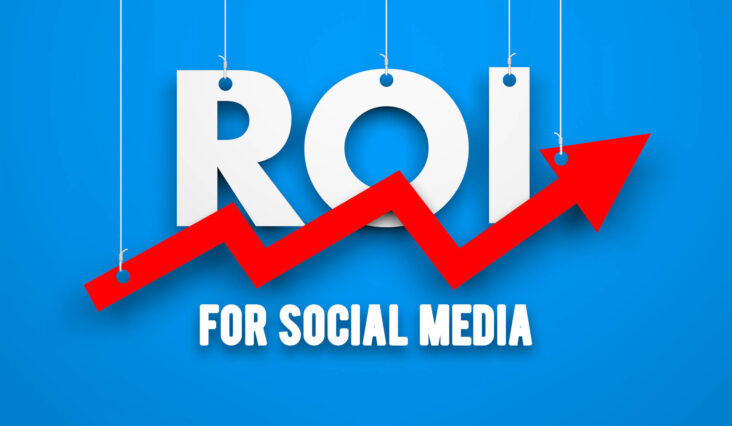The ROI Of Social Media

The result of your social media marketing efforts is known as social media return on investment, or ROI. Whether it’s better sales, greater consumer interaction, or even more brand awareness. The return a brand receives for the time, money, and effort it invests in social media marketing is known as ROI.
Generally speaking, brand exposure, customer engagement, customer retention, and customer acquisition are all included in social media marketing. Measuring these areas in terms of immediate financial advantage is not that simple. Hence, to precisely determine “Return from Social Media,” or social media ROI, marketers frequently rely on other social media KPIs and provide monetary value to these factors.
The social media ROI calculator formula can be expressed as follows:
Social Media ROI (%) = (Return from social media – Cost of social media marketing) / Cost of social media marketing * 100%
The social media ROI formula is a useful place to start, but remember that it needs careful consideration of the direct and indirect benefits of your social media efforts to provide an appropriate ROI estimate.
The value of social media ROI measurement
For several reasons, it is essential to measure social media marketing ROI. Here are some compelling arguments for why gauging social media ROI is important.
- Performance insights: They assist you in determining what is and is not functioning. Please take a look at LEGO’s approach to Instagram; it continuously tries out various content kinds and tracks how well it does. It shares various artistic content on Instagram with two main goals in mind: motivating parents and instructing and amusing children. They continue to iterate according to the lessons learned from every post. They can refine their strategy and produce more of what works and less of what doesn’t as a result.
- Allocating your budget: Measuring ROI can assist you in choosing where to put your money. Glossier, the massive cosmetics company, increased its funding for Instagram after discovering that its community-driven strategy worked there.
- Value proposition: It informs stakeholders of the benefits of your social media initiatives. Let’s use Airbnb as an illustration. It greatly improves its brand image and builds consumer confidence on social media platforms with its well-defined user-generated content approach. It may readily demonstrate to its stakeholders the worth of these efforts by presenting the ROI obtained from such initiatives.
How to calculate social media ROI
A combination of data-driven science and creativity goes into calculating the return on investment of your social media efforts. You can unleash the full potential of your social media efforts and indisputably prove the ROI with well-defined objectives, relevant key indicators, and a methodology.
So where do you start?
To start, ask yourself: what is my ultimate objective or what am I hoping to accomplish? Are you more concerned with obtaining those leads and converting them into customers than you are with increasing the visibility of your brand? Perhaps you’d like to see a sharp increase in the number of followers you have, which would boost click-through rates and conversions. Getting your audience to download your most recent white paper or fill out those lead generation forms might be your goal. Whatever it is, you must be aware of your objective.
Metrics must be used to monitor your progress after you’ve established your goals. Think of them as the indicators of your performance on social media.
Participation
This indicator shows how engaged your audience is with your brand and content on social media. Do users enjoy, share, and leave comments on the stuff you post? Shares, clicks, likes, and even brand mentions are all tracked. A high level of engagement indicates that your material is both relevant and resonates.
Reach
This metric is a number that measures how many people view your content and how far it travels in their feeds. Understanding your audience size and the extent to which your material is shared is crucial since it will provide you with a reasonable estimate of the number of eyes your content has drawn, even though reach can be more difficult to evaluate than engagement.
Leads
Social networking is a potent tool for generating leads. Gaining insight into the platforms and kinds of content that draw in new clients can greatly improve return on investment.
Transformations
Ultimately, you want to see the material you’ve worked so hard to create his, her, their, etc. convert. after it has been created. To gauge how many people genuinely adore your material and are prepared to take action based on it, use it as a yardstick. Use UTM parameters on your broadcast links so that you can track clicks at the campaign and platform levels to measure this efficiently.
Five tips to maximize social media ROI
Let’s finally discuss how to raise your return on investment via social media. Finding strategies to maximize return on investment (ROI) requires constant work. For better social media ROI, check out our five suggestions below.
Understand your audience enough
Determine who your target market is and what specific needs they have from you on social media. Assume the role of Sherlock Holmes and try to read their minds. To comprehend what motivates and influences people, you must have access to their inner thoughts.
Never be afraid to experiment with your content.
Creating content that resonates with your audience is essential to standing out amidst the cacophony and disorder of social media. What makes your content strategy unique? Instead of monotonously publishing article after post, use all of your attention to producing material that appeals to readers of all ages. Recall that quantity is never superior to quality!
Leverage social media lead generation to your advantage.
There’s a good reason why 15% of marketers’ budgets go toward social media, according to Statista’s analysis on the topic. You can obtain customer information while also providing them with something of value if you incorporate lead-generating forms into e-books or white papers and distribute them on social media.
Make it a ritual to optimize and customize.
Change things up with your posts on social media as needed. Adopt and enhance your natural social media content by using fresh images, keywords, and headlines. It’s all trial and error on social media. Try out new ad formats on paid media and monitor how your audience responds to them.
Invite the influencers to share your brand’s narrative.
As everyone knows, social media influencers have a lot of power and can use their posts to quickly increase a brand’s online visibility. Finding influencers whose ideals coincide with your company is crucial, though. When you’re first starting in the influencer community, innovative outreach initiatives can be a great way to build relationships.


